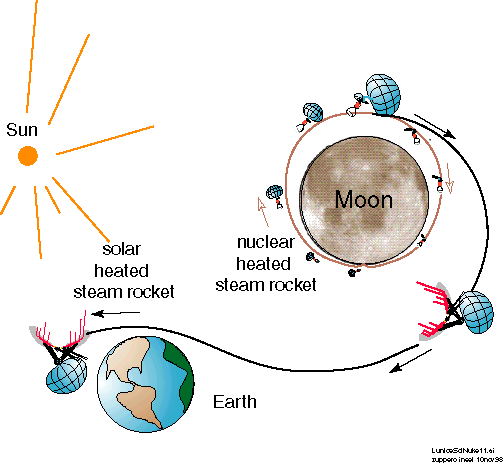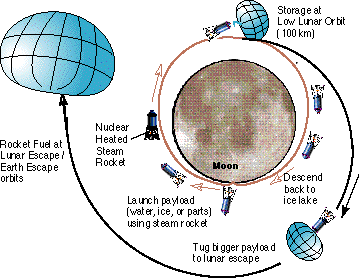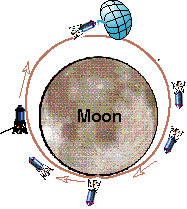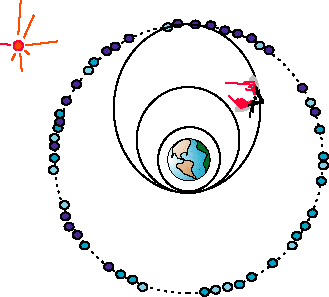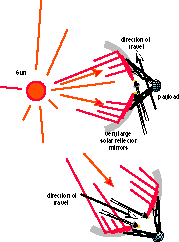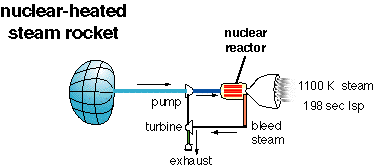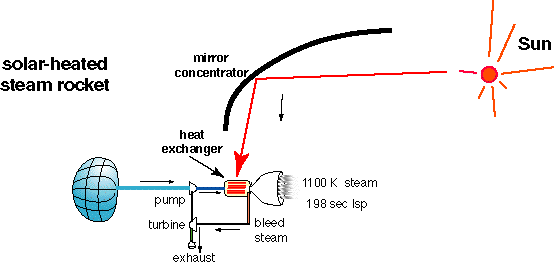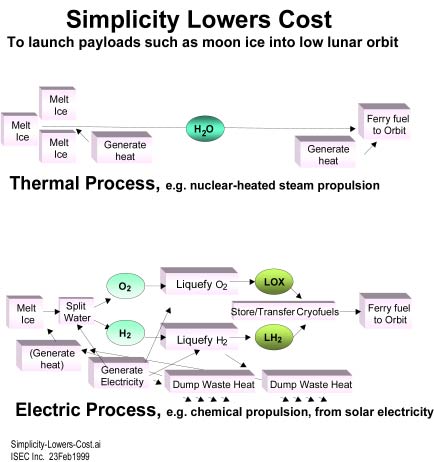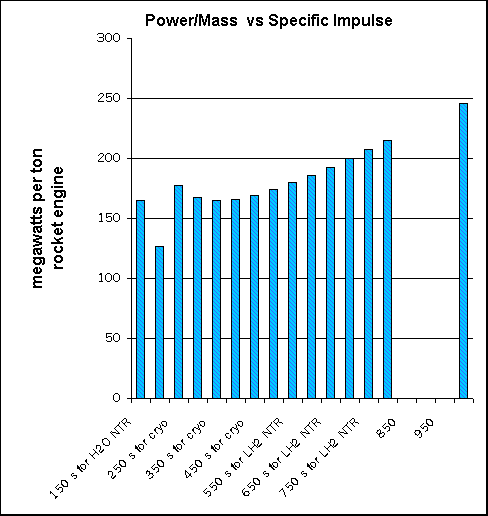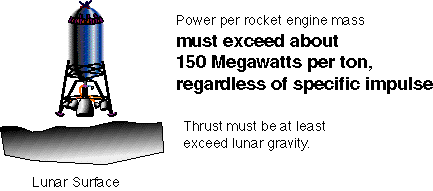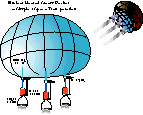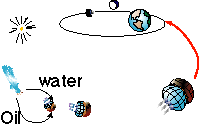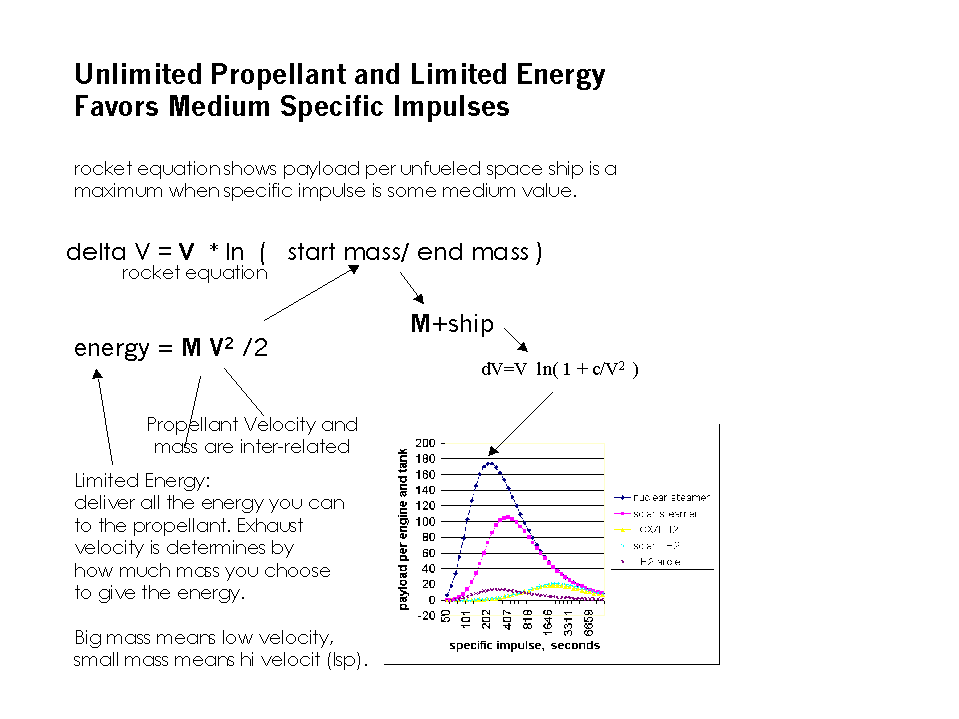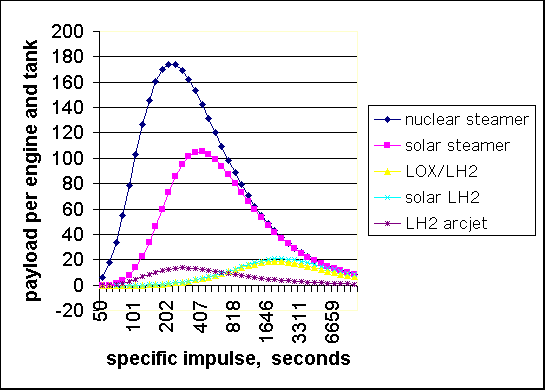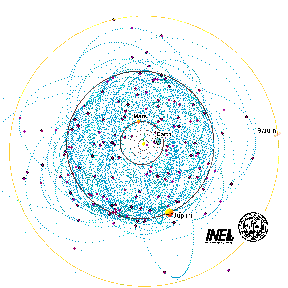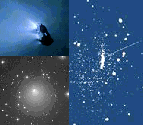15
mar 98 INEEL, mod 30 mar 1999 A Zuppero
ROUGH DRAFT
Working Paper
Moon Ice For LEO to GEO Transfers
(to take communication satellites
from low earth orbit to geosynchronous orbit)
Lunar ice could mean a fast, cell phone
internet connection.
Preliminary calculations at the INEEL**
suggested that use of lunar water, as rocket fuel and rocket propellant,
could dramatically drop the price of space transportation. This could ultimately
result in a faster, wireless internet connection, anywhere on Earth.
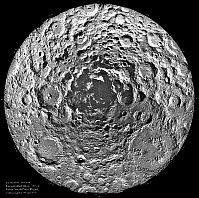
|
The discovery of ice at both arctic and Antarctic, forever dark poles
of moon was anticipated at the INEEL after the Department of Defense Clementine
mission provided the first suggestive evidence, during 1994. The data from
the NASA probe "Lunar Prospector" suggests there may exist as much as 10
Billion tons (tons, not gallons) of pure ice veins. |
** The INEEL
The Idaho National Engineering and Environmental Laboratory (INEEL)is
a United States Department of Energy national laboratory located in Idaho
Falls, Idaho. Since the early 1950's this laboratory was key to the
development of the exceptionally reliable and safe nuclear reactors used
to power the United States Navy's nuclear submarine fleet. The reactors
heat water into steam, which powers the submarine.
Scientists and engineers at the INEEL found a simple and relatively
inexpensive way to remove water ice from the lunar surface and place it
into orbit around earth. This engineering discovery would provide several
orders of magnitude larger quantities of propellant than all known affordable
alternative schemes.
Water would be used as the propellant in nuclear-heated steam rockets.
Such a rocket would haul rocket fuel payloads, such as ice, from the surface
of the moon into orbit. Solar-heated steam rockets would take the ice to
an orbit out of the moon's gravity and then into an orbit that just grazes
the atmosphere of the Earth. The orbit of the ice would slowly decay. The
result would be ice in orbit around Earth. Delivering this rocket fuel
or propellant to Low Earth Orbit could dramatically lower the cost of space
transportation. Rockets from Earth could rendezvous with the ice and use
it for rocket propellant.
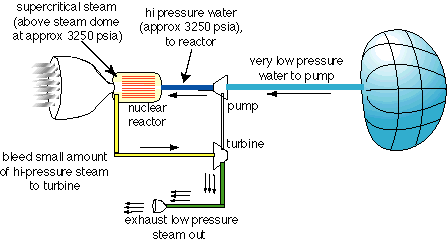 |
Lunar_Ice_Rocket
INEEL
engineers and scientists published the details of this scheme at the Joint
Propulsion Conference in Seattle, June 1997. It used lunar south pole ice
as the resource. |
Systems analysis revealed that using the lunar water directly seemed
to result in a dramatic drop in complexity, and especially a dramatic drop
in the hardware needed on the lunar surface. This architecture is sketched
below.
The architecture would use solar powered steam rocket propulsion for
all the steps beyond the low lunar orbit. The solar options permits us
to keep the nuclear system trapped in a deep gravity well in deep space.
These are discussed below.
A program to develop the steam rocket at the INEEL is described.
Generating electricity in space handicaps all known alternatives.
A bottleneck step, launching ice from the surface of the moon to low
lunar orbit, strongly favors a nuclear-heated steam rocket. All other known
options require orders of magnitude more support and processing hardware
to achieve the same results. Generating electricity in space causes the
problem.
Generating electricity in space requires hardware that weighs about
1000 times more than that of the steam scheme. This means alternatives
cost 1000 times more.
NASA and others suggested that one could use electrolysis to split the
water, which would give hydrogen and oxygen gasses. These would then be
refrigerated and condensed into the same cryogenic liquid rocket fuels
used by the Shuttle. This approach requires that all the energy be supplied
by electricity. This alternative would therefore cost about 1000 times
more than the steam scheme.
The INEEL scheme DOES NOT use electricity as the energy source.
Architecture for Lunar Water for LEO
to GEO Transfers
The objective is to fuel a propulsion system that takes payloads to
GEO once they are delivered to LEO. Communication satellites operate at
GEO (geosynchronous orbit). Rockets take payloads to LEO (low earth orbit).
The propellant or fuel would be water obtained from the North or South
poles of the moon.
A small nuclear heater melts ice at the forever dark North or South pole
of the moon. A condenser collects the water vapor, providing pure water.
A nuclear-heated steam rocket launches water or ice from the moon poles
and delivers it to low lunar orbit.
A solar-heated steam rocket transfers payloads from low lunar orbit to
an earth transfer orbit.
The ice payload, covered by a low mass heat shield, grazes the earth's
atmosphere and looses a small amount of velocity. This lowers its apogee.
It grazes the earth's atmosphere repeatedly until its orbit is a nearly
circular, low earth orbit. A Mars probe is using its solar panels as an
incremental aerobrake to achieve just this kind of result.
Small solar-heated steam rockets take payloads from LEO to GEO, using water
propellant. A systems analysis may show that splitting the
water and using the resulting gasses directly in a chemical rocket may
reduce costs. It may even show that splitting water at LEO is reduces costs.
The availability of massive (1,000 ton units) of water ice at LEO would
offer a new degree of freedom in commercial space operations.
(click
for hi res image)
Solar thermal
rockets are similar to nuclear heated rockets. Inflateable mirrors focus
the sun on a heat exchanger.
Using water to take payloads from LEO to GEO uniquely provides a path
for cash flow, to pay for such space resource utilization schemes.
Easy access to GEO means faster wireless internet connections.
Steam rockets use water
propellant
A steam rocket is a rocket with water vapor exhaust. The Shuttle main
engines burn LOX and Liquid Hydrogen LH2 to produce steam exhaust.
A nuclear or solar heated steam rocket delivers heat to a heat exchanger
to generate steam. Some of the steam can be used to energize a turbo-pump
to increase the heat exchanger pressure, which increases performance.
Exceptional Simplicity
The nuclear-heated option provides an exceptionally simple architecture.
A relatively small nuclear heater provides enough energy to heat shovel
plates to cut through the extremely cold, 80 Kelvin permafrost. A small
nuclear electric generator would provide 100 Kilowatts for headlights,
computers and communications. It would weigh several tons mass and shed
3 Megawatts of "waste" heat. A small nuclear heater (3 Megawatts) provides
the heat (3.5 megajoules per kilogram) needed to vaporize the ice (27,000
tons per year) to room temperature vapor. A condenser collects the pure
water.
The nuclear-heated steam rocket then uses the water as propellant to
launch payloads to low lunar orbit.
In sharp contrast, splitting
the water requires a complex and heavy architecture. This is a chemical
propulsion option, using electrolysis. The chemical option requires that
all the energy stored in the LOX and LH2 rocket fuels originate first as
electricity. Electric generators in space are severely handicapped because
they have neither convective nor conductive nor phase-change heat sinks.
Space is a thermos jar. Masses per unit energy are typically 10,000 times
greater than the purely thermal processes of the steam rocket option.
Compressing and refrigerating the gaseous oxygen and hydrogen to make
them liquid cryofuels also takes compressors and heat sinks. The refrigerator
for the LH2 requires more electricity than splitting water, and is not
very efficient because LH2 is at 22 Kelvin.
The chemical option is complex and requires massive hardware to deliver
comparable payloads to LLO.
The only advantage of the chemical option is that it uses about 3 times
less water than the nuclear option.
Minimum Thrust Is Required
Launching from the Lunar surface requires at least sufficient thrust to
overcome the crushing gravity of the moon. Lunar gravity is only 6 times
lower than that of Earth. (Comet gravity is 100,000 times lower.) A parametric
analysis showed that the minimum specific power (power per rocket engine
mass) must exceed about 150 megawatts per ton engine, or the rocket will
not lift of the lunar surface. If the specific impulse is too low (less
than about 120 seconds) or too high (greater than about 1000 seconds) the
required specific power increases sharply.
A LOX/LH2 rocket (RL-10) can achieve about 1300 megawatts per ton engine.
A nuclear heated steam rocket to develop this specific power needs to
provide a mixed mean outlet steam temperature into the nozzle of about
1100 Kelvin. This is half the temperature of the NERVA rocket (> 2500 Kelvin)
demonstrated during the late 1960's. The specific power density in the
core is something between 1 and 3 megawatts per liter of reactor core.
The specific power is less than that of NERVA (3 megawatts per liter).
END of Document
Technical Details and Background
|
|
An INEEL scientist first proposed using ice from space
at the First International Conference on Near-Earth Asteroids, June 1991.
Another paper presented at the World
Space Conference, 1992, detailed how steam rockets heated by nuclear
reactors would use water ice taken from a little known and accessible comet
formation in the space between Mars and Jupiter to transport tens of thousands
of tons of payload. The payload would have been more water ice, or possibly
the hydrocarbons found on comets. The destination was an orbit around Earth
itself. |
Unlimited Mass Changed Meaning of the Rocket
Equation
A thermal rocket can deliver its heat to however large or small a propellant
mass that is convenient. This permits the thermal rocket to choose its
specific impulse. However, the thermal rocket has only a limited amount
of energy to deliver. In every case known, it will deliver as much energy
as it can for as long as it can. This contrasts a chemical rocket, where
the energy in the fuel is directly proportional to how much fuel is in
the tank.
Thermal rockets use a slightly different form for the rocket equation.
The rocket equation gives the change in velocity a rocket will experience
after all the propellant is exhausted. The energy available and the chosen
specific velocity determine how much propellant mass is used. The specific
velocity, V, is the product of specific impulse, Isp, and gravity at earth
surface, 9.8 m/s/s.
The consequence is that increasing the specific impulse beyond an optimum
value will make the rocket go slower or deliver a smaller payload. For
the ideal case, the optimum specific velocity (rocket exhaust velocity)
is about 2/3 the mission delta-V.
This does NOT minimize the amount
of propellant used. The optimum specific velocity results in the
propellant requirement of about 4 times the payload. The assumption is
that
"mass is plentiful in space."
Near Earth Asteroids (NEA's)
and comets have 1E8 to 1E15 tons mass, with near zero gravity. So if
one docks with a nearly zero gravity object in the space near earth, one
has access to "nearly unlimited mass." The moon has almost to much gravity
to qualify as a zero-gravity object.
However, energy is not free. And peak power is definitely
not free. This situation favors all propulsion processes that use heat
alone, and strongly dis-favors processes that require electricity.
The unexpected result of the thermal-rocket equation is that the optimum
favors steam rockets for lower delta-V missions. "Lower delta V" means
under about 4000 m/s. INEEL
scientists published architectures for such missions,
(click here for architecture
image) which included going to Mars from a high earth orbit, going
to the outer edge of the asteroid belt from a high earth orbit, for delivering
payloads from Low Lunar Orbit to GEO, or for going from LEO to GEO.
Further, water has a uniquely low (7 mm Hg) vapor pressure just above
its melting point. This permits tankage fractions under 1%. Extracting
water from space ice requires only a room temperature thermal process.
These engineering factors make water even more desirable. For example,
missions to return massive payloads back to Earth orbit from the Jupiter
family comet formation, with delta-V as high as 6500 m/s, become highly
competitive compared to chemical or other propulsion options.
Technical Program Considerations
The critical path is the nuclear heater with sufficient power per mass
to achieve launch from the lunar surface.
INEEL scientists and engineers determined that the current state of
the art of water cooled nuclear systems strongly suggests the required
system can be constructed. The 4 engineering options identified for
nuclear fuel elements are:
Concept 1: A BWR-like reactor design that maximizes utilization
of existing reactor technology base. Likely based on UN fuel with stainless
steel clad. Several steel candidates have been identified. This is the
path with the least technology development.
Concept 2: An annular fuel, BWR-like design that exploits a relatively
straightforward extension of Concept 1. The use of annular fuel will limit
peak fuel temperatures in the solid cylindrical rods of Concept 1. The
fuel inside the annulus can be solid,liquid or gaseous This concept also
provides automatic axial power flattening during life and provides an easy
mechanism to control radial power flattening during the design process.
Concept 3. Steel clad plate fuel design. Can utilize flat (or
curved) plate fuel to increase achievable heat transfer and therefore increase
power density. Same principle as utilized in the ATR.
Concept 4. Particle bed design inherently provides an exceptionally
high heat transfer capability and therefore an exceptionally high power
density. This concept provides the potential for the highest performance
but at the cost of the highest technology development with inherent costs
and risks.
Technical Elements
A program to develop the nuclear fuels and a high-peak power nuclear
reactor would have the following elements:
1. Concept Definition and Concept Development
Technical Discussion
Minimum required performance characteristics for a nuclear steam rocket
to ferry water from the lunar surface to low lunar orbit have been identified
in terms of the power-to-weight ratio. Power-to-weight ratios and power
densities in excess of the required value have been demonstrated (NERVA)
for devices using hydrogen as the coolant/propellant. Power densities in
excess of those believed to support the needed power-to-weight ratios are
achieved in aluminum clad U-Al(sub x) plate fuels (such as ATR) operating
with relatively low temperature water.
The current experience base is not adequate to project how mundane (or
how exotic) an approach might be required to achieve an adequate power
density and power-to-weight ratio in a reactor utilizing approximately
1100 K steam as the coolant and propellant. Concept definition and evaluation
work is required to estimate what performance can be achieved.
Four concepts have been identified for preliminary evaluations. The
first draws heavily on the existing reactor technology base. The fourth
offers exceptionally high performance potential but also represents the
greatest technology development effort.
Serial evaluation of the concepts is proposed. Evaluation of the first
may yield performance estimates that suggest moving immediately to the
fourth concept. Evaluation of the first may also indicate adequate performance
is achievable with the first and suggest moving immediately to Phase II
for Concept Development and Evaluation.
Nuclear-heated Steam Rocket Program
Given the above background, the opportunities are ripe for the INEEL to
get in at the start on a development that could have a significant influence
on the future of space travel and exploration. The following are ideas
for a skeleton program plan at the INEEL for the design of a nuclear reactor
that could power a steam rocket.
Issues related to he development of a nuclear reactor for use in a steam
rocket
Clearly there are many issues that have to be addressed in the development
of a nuclear steam rocket. At the top level of conceptual design efforts,
these issues should include:
• reactor design/performance including
• fuel element design,
• fuel configuration,
• cooling system,
• safety systems
• rocket nozzle including
• design,
• configuration,
• performance
• materials performance (stress, strain, corrosion, temperature, neutronics,
etc. effects on strength) investigations including
• fuel cladding,
• cooling system,
• nozzle,
• related support structure
The elements of a program necessary to produce a conceptual design will
include the tasks needed to address the above issues. These elements include:
1. Requirements Definition - detailed requirements for the overall
lunar water truck will be developed so that the definitive requirements
for the power plant (the nuclear powered steam rocket) can be derived.
Economic analysis, mission profiles, payload analysis, support facility
definition, and the like will necessarily be developed in conjunction with
affiliated agencies such as NASA, possibly Lockheed Martin Corporate, etc.
to ensure all necessary requirements for the propulsion system are defined
and can be factored into the conceptual design analysis.
2. Reactor Design Concept Development - At present, it is suggested
that there are up to four possible configurations for a reactor design
(e.g. boiling water reactor, pressurized water reactor, particle bed reactor,
etc.) and fuel/fuel configuration (enrichment, plates, rods, pellets, etc.)
combination that might fulfill the (expected) requirements. A significant
part of the program effort will be devoted to identifying the pertinent
details of these configurations, developing conceptual designs, and addressing/analyzing
the ability of a given configuration to ultimately meet the specified requirements.
To conduct tasks associated with the specification and conceptual design
of reactor systems, it is anticipated that personnel versed in reactor
physics, fuel design and performance, thermal cycle and heat transfer analysis,
applied mechanics (stress analysis), and mechanical design will be required.
Details associated with the general nature of the tasks to be performed
by these personnel include:
Reactor physics, fuel design and performance - to obtain the
(expected) required power to system mass ratio, it is likely that new ideas
(e.g. core, fuel, fuel containment, etc.) must be developed and tested.
Core designs featuring these new ideas and different fuel types must be
considered, developed, analyzed analytically, and eventually tested. Experienced
reactor physics and fuel performance analysts will have to design the fuel
and core configurations and adapt these to considered reactor designs.
It is expected that current generation analysis codes (such as FRAPT-4,
sn and shielding calculations) along with traditional hand calculations
will be required to accomplish this task.
Thermal and heat transfer analysis - Thermal, heat transfer,
and fluid flow analysis will have to be conducted for every specific reactor
core configuration and balance of system. Questions to be addressed in
these analyses include how efficiently core energy generation is transferred
to the cooling medium and how reactor operating conditions and environment
influence the thermal and thermal hydraulic conditions at the nozzle entrance.
In essence, hand calculations along with analysis using current reactor
design and performance codes (such as RELAP5) will be used to examine the
performance and behavior of the reactor and system for a wide variety of
steady-state and transient operating conditions. Given the plausibility
of new fuel designs, literature will have to be searched to find appropriate
correlations to support this analysis. Clearly, these calculations will
be iterative in nature as the design concepts continue to develop. Thermal
analysis must also be conducted to estimate the performance of the nozzle
attached to the reactor. Through a combination of hand calculations and
computational fluid dynamics analysis, a map of the nozzle performance
(e.g. ISP) as a function of thermal-hydraulic conditions (e.g. temperature,
quality, flowrate, void fraction, pressure) at the nozzle entrance will
be generated. This map will be generally useful in that the results should
be independent of the reactor concept for the most part.
Mechanical Design - Mechanical design will be conducted for each
configuration proposed. This task essentially determines what the various
reactor components are and how the components fit together to compose a
working system. Details of component equipment pieces (such as pumps),
piping system design and layout, packaging, control system, and so forth
will be defined in this task.
Mechanical/Stress Analysis - As with any design, analysis must
be conducted to address the performance of the materials and components
of the system to ensure that they are not unnecessarily overloaded or over
stressed during the design life of the system. Many factors must be considered
including the fuel, fuel cladding, fuel support structure, piping, piping
support system, nozzle, and so forth.
It is expected that each of the above tasks will require 1 FTE to examine
two configurations. Thus 8 capable FTEs will be required to develop and
analyze the four potential concepts.
Other tasks supporting the above will be required. These tasks include:
Requirements Development - A requirements document will need
to be development. This document will
address primarily top-level requirements for now which will be refined
as time goes on. Assumptions with regard to cost, schedule, reliability,
performance capability, etc. will have to be factored in and shown. Potential
mission scenarios will have to be documented. Methods for evaluating
design tradeoffs will have to be developed. Interfaces with man and
potential NASA launch vehicles will have to be addressed.
Safety - We will need to develop a Safety Program Plan
similar to that for the Multi-Megawatt Space Reactor Program. This
Plan should address the top-level safety requirements, how safety will
be managed and control within the program, who will have what safety responsibilities,
what safety documents will have to be generated, and what safety milestones
and schedules have to be met. Safety interface requirements with humans
and potential NASA launch
vehicles will have to be defined. A Safety Plan for the Concept
Development Project should also be developed which relates the overall
Safety Program Plan to specific design concepts and lays out safety
requirements for each. Real work, as Bruce describes it, would
involve developing potential safety approaches for each concept and performing
preliminary fault tree analyses, failure modes and effects analyses,
criticality analyses, etc. on the preliminary design concepts.
Function and Operations - As mentioned above, detailed requirements
for all aspects of the project must be developed and maintained. This includes
functional and operational specifications, safety requirements, disposal
requirements, and so forth.
Materials Testing - New materials or derivatives of existing
materials may have to be developed to support the mechanical and operational
requirements and needs of the concept design. Materials for cladding, nozzle,
piping system, etc. will need to be examined in high temperature, corrosive
steam environments similar to that expected during reactor operations to
determine material performance. The INEEL Supercritical Water Oxidation
Loop may well be capable of doing coupon testing required to support these
needs.
Mission Development - Mission profiles and plans will likely
be developed by other participating agencies. However, the INEEL must remain
closely involved in these developments. First, it must be ensured that
mission profiles fit within the assumed/established requirements for the
reactor designs being considered. Second, the INEEL needs to remain in
the decision making process associated with the profile developments to
ensure that the best interests of the INEEL can be realized and future
prospects can be capitalized on.
It is expected that with the exception of the Materials Testing, each of
the above tasks will require 1 FTE to support all the design configurations
contemplated. Materials Testing will require 4 FTEs to support all the
concepts. Thus 8 capable FTEs will be required to develop and analyze the
four potential concepts.
Based on the above discussions and preliminary task definitions, 16
FTEs for 1.5 years would be necessary to effect the conceptual reactor
design(s).
principal author:
anthony zuppero
nuclear and reactor
physics: bruce schnitzler
thermal hydraulics,
engineering analysis and experimetal programs: tom larson
nuclear propulsion
and power, reactor concepts and DOE HQ interface: ralph bennett
safety, functional
and operational requirements: john rice
strategic: don yurman
systems: dave nipper,
lyn parlier
extraneous elements
deleted because they are obvious to all:
Project Management
- A capable project manager will be required to coordinate and ensure the
project goals are accomplished within schedule and budget limitations and
that a team environment is maintained.
Chief Scientist
- A visionary will be required to help expose the project, define the limits,
ensure a broad support base for it, lead the project in the directions
consistent with the best interests of those involved, and protect the project.
It is expected that the Chief Scientist would help develop beneficial collaborations
with appropriate entities (such as NASA, other Labs, commercial entities,
etc.) and help develop and maintain the funding base.

